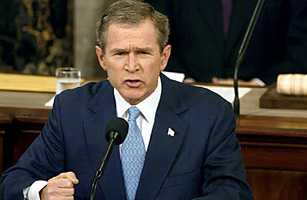
Bush delivering his pivotal State of the Union address.
Jan. 29, 2002
In late December 2001, chief presidential speechwriter Mike Gerson made a simple request whose repercussions would be felt around the world. "Here's an assignment," he told his colleague David Frum. "Can you sum up in a sentence or two our best case for going after Iraq?" President Bush had yet to decide to target Saddam Hussein, but he was moving in that direction and wanted a rationale for overthrowing Saddam in his State of the Union address. As Frum wrote later in his book, The Right Man, "I was to provide a justification for a war."
Frum needed to explain why Saddam, even if he wasn't involved in 9/11, should be a target in the war on terror. What linked Saddam with Islamic terrorist groups, Frum thought, was their hatred of Western democracy. In that way, they were similar to the Axis powers of World War II. In his memo to Gerson, Frum called Iraq part of "an axis of hatred," but Iraq was the only member singled out at that point.
Frum never expected his stern language to pass the President's lips. But as new drafts were written, it stayed in the speech. Gerson injected theology into the key phrase, turning "hatred" into "evil." By mid-January, Bush had decided that Saddam had to go. Other countries were added to the axis — first Iran, then North Korea. In the address, Bush declared, "States like these constitute an axis of evil, arming to threaten the peace of the world." Frum's simple assignment had given birth to the defining phrase of a presidency.